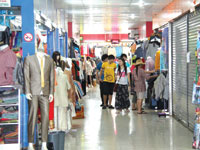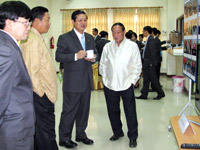Toyota to set up production base in Laos
Toyota to set up production base in Laos
Toyota, a Japanese multinational automaker, will establish a production base in the Savan-Seno Special Economic Zone (Zone C) in Savannakhet province to manufacture vehicle interior components for export.
The company will invest US$5.6 million to build the factory on a site of about 80,000 square metres. The plant will be able to turn out 200,000 units per year.
When production starts, about 180 people will work at the new facility, providing job opportunities for local people.
The affiliate company will be known as Toyota Boshoku Lao Company Ltd, part of the Toyota Boshoku group. This is the first time the group has set up a production base in Laos.
The company will serve as a satellite complementing the Toyota Boshoku group production base in Thailand. It will start producing interior components such as vehicle seat covers in April 2014, and supply them to seat-manufacturing plants in Thailand.
By setting up a base in Laos, the Toyota Boshoku group is seeking to further optimise production and distribution in the Asia and Oceania region, which is a crucial market. Toyota Boshoku will continue to offer customers worldwide appealing, comfortable and safe automobile interior space.
Head of the Investment Promotion and Legal Affairs Division at the Sava-Seno Special Economic Zone, Mr Phanomkone Dararasamy, told Vientiane Times yesterday the company is preparing to build the plant.
When asked why Toyota wanted to invest in Laos, Mr Phanomkone said Laos is a peaceful country which is steadily becoming integrated with the rest of the region and the world.
“One of the most important things is that more facilities are available in the zone now, including electricity and water connections,” he said.
Road No. 9, linking central Laos to Thailand, Vietnam and the rest of the region has been improved to facilitate business activities along the East-West Economic Corridor.
The government attaches great importance to foreign investment, which is needed to drive the country's economic growth. Ultimately, strong and inclusive growth will help people to rise above poverty and enable Laos to graduate from the list of least developed countries by 2020.
The government has authorised the Malaysian investor Giant Consolidated Limited to build a US$5 billion high-speed railway to link Savannakhet to the Lao-Vietnamese border (Savan-Laobao rail).
Work on the track is expected to commence this year and trains will be able to travel at a top speed of 120km per hour. The venture will give momentum to Laos' goal of shipping goods to regional and international markets and will also boost tourism.
The current problem for the land-locked country is the high cost of freight transport to other countries, but when this railway is complete it will help to bring in more foreign investment
vientiane times















